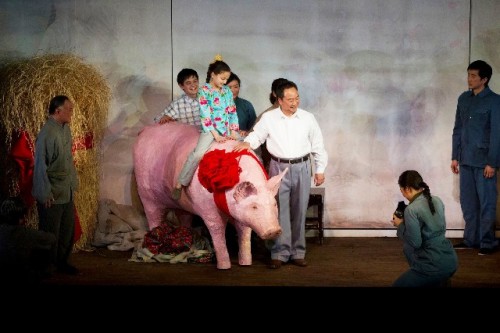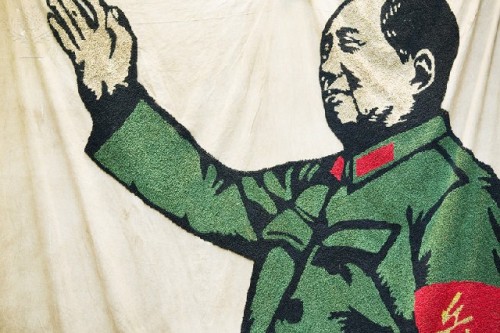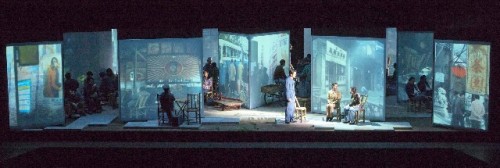Panoramic Wild Swans At American Rep Theatre
Visually Spectacular But Problematic Drama
By: Mark Favermann - Feb 17, 2012
Wild Swans
Written by Jung Chang
Adapted by Alexandra Wood
Directed by Sacha Woods
Scenic Design, Miriam Buether; Costume Design, Tom Pand; Lighting Design, DM Wood; Sound Design, Gareth Fry; Video Design, Wang GongXin; Movement Direction, Leon Baugh; Projection Design, Tim Reid; Music Direction, Joanna Zenqhui Qiu; Puppet Design, Michael Fowkes
Cast
Yu-Fang, Julyana Soelistyo
De-Hong, Ka-Ling Chueng
Shou-Yu, Orion Lee
Ting, Celeste Den
Bolin, Jon Kit Lee
Heng, Victor Chi
Zhen, Joanna Zenghui Qui
Huifen, Joanna Fong
Dr. Wan, Eric Chan
Governor Lin, Ron Nakahara
Team Leader Chi, Les J.N. Mau
Teacher Shu, Jennifer Lim Ai Hau
Er-Hong, Emme Fuzhen Ricci
Niu, Nekhebet Kum Juch
Dai, Annie Chang
Weimin, Oliver Biles
Er-hong, Katie Leung
The production is 90 minutes long with no intermission
A co-production of the A.R.T. with London's Young Vic Theatre Touring Company
At the Loeb Drama Center
64 brattle Street
Harvard Square, Cambridge, MA
americanrepretorytheatre.org
Feb 11 through Mar 11
Wild Swans is a visually stunning but dramatically unsuccessful play with great theatrical promise. The drama is based upon Jung Chang's family memoir, following the lives of three generations of women through China's rather catastrophic last half of the 20th century.
Written two years after Tiananmen Square, Jung Chang's Wild Swans was an international bestseller that was readers' first comprehensive insight into life under the Chinese Communist regime. This stage adoptation of the book truncates the epic span over several decades into panoramic and intimate vignettes in 90 minutes.
If this co-production with London's Young Vic Theatre Touring Company is literally an out of town (actually out of continent) tryout, then there is much to do to prepare the play for presentation during the 2012 London Summer Olympics. The good news is that there is time to impove it strategically.
The poignant memoir has been undramatically adapted to sound like Pearl Buck's rather wooden characterizations that lacked any real dramatic (or even sexual tension). Dialogue was much too formulaic, and earnestness was substituted for nuanced passion or emotion.
Instead, the epic quality of the sometimes quite stunning sets and visual environments were used to infuse the narrative with a vividness and even pictorial passion. In fact, the best characters in the play were the sets. They "spoke" better to the sweep of Chinese history than the mostly cardboard characters and stilted dialogue.
As the audience is being seated, there is a pre-Communist peasant village market set across the width of the stage. This variation on a tableau vivant was lively, noisy and bosterous rather than still, quiet and contemplative. This many person pre-scene had a vibrancy that later scenes often lacked.
The first intrusions into the peasant market are communist soldiers proslytizing through puppets the evil of the warlord/landlord and the suffering of the peasants. Though the puppets were well handled, the story was too expected and sterotypical. Passionless, everything seemed to be by rote: The evil war lord, a sexually abused peasant girl, the corrupt official and an exploited peasant.
This obsessive earnestness permeates the play. It is continually reinforced by Orion Le's character Shou-Yu, often to family members' and his own detriment. Unfortunately, this is a stubborness of purpose, not a true sense of pride or even moral true north on the compass of life.
It is the way things must be for him. It is assumed that any compromise, or a realistic sense of nuanced humanity, is metaphorically the way the Chinese people survived. Dramatically it rings hollow.
One scene is particularly cartoonish during the Cultural Revolution. As the true believers wave flags and slogans, denounce those whom they deem inappropriate, they sing "Katow to Chairman Mao." Perhaps, the adaptor of the book was looking for a shorthand way to address the terrible period of mindless devotion and cruelty by the mob? It was dramatically weak and too obvious.
Many of the scenes are visually spectacular. The two most visually eloquent were the scene in the rice paddy and the one showing the opening up of the industrialization creating urbanization in emerging Chinese cities. Yet, the dialogue in the rice paddy and the conversation in the coffee house were wooden and unnatural. The broken family members' words did not resonate with each other or the audience.
However, the stage sets were spectacular environments. The incredibly evocative video behind the rice paddies was visually poetic. Panoramic also was the Red Guard trial of husband and wife with flags and video of Mao's head surrounded by rays of red sun stretched across the stage. The fractured video screens evoked the alleyways and narrow streets of the city. Here, the depth of the stage was used to convey urban images of congestion, vitality and noise of modernizing post-Mao China.
Apparently little changed over the decades from rural to urban China. The father was still quite stubbornly rigid. This was a fatalism that allowed for subjugation and dictatorship. Corruption still existed. Officials still took from deserving others. A denied scholarship to study abroad echoed an official earlier pocketing wages due to a peasant.
The end of the play was a surprise. It just sort of ended. The spotlight shined on the liberated daughter, and the stage went black. The audience seemed unsure that the play ended. What happened to her? How did she get out (escape) China? How did she actually get to tell this story?
Within Wild Swans there is a dramatic thread that can be developed and refined. The story could be poignant and the characterization could be nuanced. This is epic storytelling that needs theatrical narrative insights. Jung Chang's original memoir has the ingredients. It is too bad that the adaptation is so threadbare.
Strengthening dialogue or even eliminating some of it and allowing the tableau nature of the scenes to speak for themselves may be one approach. Certainly a better resolution of some sort of the ending would frame the story better.
At this point, Wild Swans is a play that should be seen if not heard. It needs a realistic voice.










